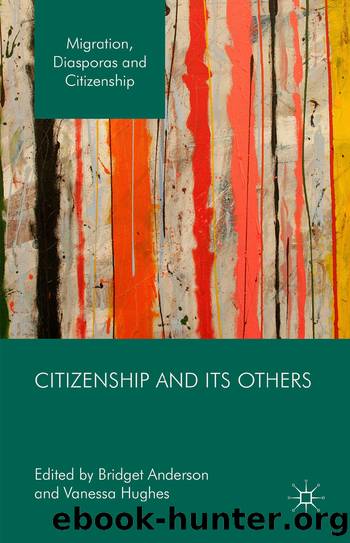Citizenship and Its Others by Bridget Anderson & Vanessa Hughes

Author:Bridget Anderson & Vanessa Hughes
Language: eng
Format: epub
ISBN: 9781137435095
Publisher: Palgrave Macmillan
Neo-racisms and the postcolonial new world order
The ascendency of the new post-WWII system of nation-states has been accompanied by a shift in racist discursive practices. As the âneat, symmetrical unitsâ of the nation-state have become co-terminus with âsocietyâ (Gilroy, 1993), the idea that the institutional form of the nation-state perfectly reflects the truth of the existence of fixed, stable and, most importantly, incommensurable âculturesâ or âethnicitiesâ and âculturalâ or âethnicâ identities has gained ascendency. The deep racism of such a structure is represented as just the ânaturalâ order determined by geography. The postcolonial new world order, thus, is very much dependent on the nationalization of people and place and the linking of the two into a new spatiality of power.
In the postcolonial new world order, especially as its neo-liberal turn came to dominate in the 1980s, what has been called a âdifferentialist racismâ (Taguieff, 1990) or simply âneo-racismâ (Balibar, 1991: 52) has taken hold. As compared to the âold racismsâ with their ideas of innate biological difference (and vertical hierarchy), neo-racisms rest on ideas of innate cultural differences (and horizontal hierarchies). While Robert Miles (1993) points out that the culturalist emphasis of much of todayâs racisms may not, in fact, be so novel; today, racist practices are âlargely based on the argument that it is futile, even dangerous, to allow cultures to mix or insist that they do soâ (Hardt and Negri, 2000: 192).
Neo-racisms were a response to the delegitimization of the âoldâ racisms. As reports circulated of the WWII-era extermination of millions of Jewish and Romani people in Europe because of their categorization of âinferior racesâ by fascists, racist arguments based on biological superiority/inferiority became much easier to challenge. The mainstreaming of this rejection was perhaps most notable in the 1950 UNESCO report confirming that there was no scientific basis for the claim that the idea of âraceâ marked the boundaries between different âtypesâ of humans. Recognizing the social construction of ideas of âraceâ was (and remains) an important victory for anti-racism. However, because the material basis for the usefulness of racist ideologies that separated people from one another remained, a discursive shift took place. The exclusions and forms of discrimination embedded in ideas of ârace-as biologyâ shifted to ideas of ârace-as-cultureâ or, more succinctly, as âethnicityâ.
The basis of neo-racism is what Mahmood Mamdani (2004) calls âculture talkâ which, with no trace of irony, asserts that each purportedly separate and distinct âcultureâ has a tangible essence that defines it. The base assumption of neo-racism is that racialized (or âethnicâ) boundaries are ânatural bordersâ (Mamdani, 1998). The process of ethnicization asserts that each ânationâ is said to feel a strong need to maintain and protect its seemingly distinct and discrete identity. In this mixture of âraceâ and âplaceâ each ethnicized group lays claim to âits ownâ territorial space. In this sense, all ânationsâ aim to be âethnic groupsâ. Those people with another âcultureâ â non-members of the ânationâ â are re-presented as a grave threat to the existence and viability of ânational cultureâ.
Download
This site does not store any files on its server. We only index and link to content provided by other sites. Please contact the content providers to delete copyright contents if any and email us, we'll remove relevant links or contents immediately.
Zero to IPO: Over $1 Trillion of Actionable Advice from the World's Most Successful Entrepreneurs by Frederic Kerrest(4074)
Machine Learning at Scale with H2O by Gregory Keys | David Whiting(3658)
Harry Potter and the Goblet Of Fire by J.K. Rowling(3619)
Never by Ken Follett(3548)
Ogilvy on Advertising by David Ogilvy(3351)
Shadow of Night by Deborah Harkness(3182)
The Man Who Died Twice by Richard Osman(2821)
Book of Life by Deborah Harkness(2726)
My Brilliant Friend by Elena Ferrante(2707)
How Proust Can Change Your Life by Alain De Botton(2620)
0041152001443424520 .pdf by Unknown(2608)
Will by Will Smith(2592)
The Tipping Point by Malcolm Gladwell(2566)
How to Pay Zero Taxes, 2018 by Jeff A. Schnepper(2505)
Purple Hibiscus by Chimamanda Ngozi Adichie(2502)
Hooked: A Dark, Contemporary Romance (Never After Series) by Emily McIntire(2428)
Rationality by Steven Pinker(2159)
Borders by unknow(2121)
Daughter of Smoke and Bone by Laini Taylor(2086)
